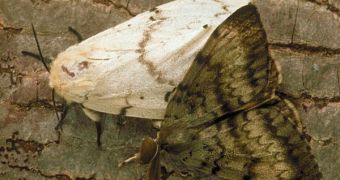The "green revolution" of the agriculture threw enormous quantities of poison (read "pesticides") on the cultivated fields.
Many still persist (especially those with chlorine) and huge amounts are still used to ensure the harvest.
A solution to reduce contamination would be the use of the bacteria against insect pests. The oldest species employed is Bacillus thuringiensis (Bt), which is especially effective against caterpillars.
Now a bacterium discovered by a team at Agricultural Research Service (ARS) and found to be toxic to Colorado potato beetle is continuously increasing its array of activity to gypsy moth, small hive beetle and tobacco hornworm.
The new bacterial species, Chromobacterium subtsugae sp. nov. was encountered in soil rich in decomposed leaves of hemlock (Tsuga species), a coniferous species, collected from the Catoctin Mountain region in central Maryland. The bacteria were isolated by suspending samples of forest soil in water and then cultivated directly in a glucose-free medium.
The bacteria in the samples initially grew small and cream-colored colonies, which progressively turned to light-to-dark violet from the center of the colony outward. 50 % of small hive beetles (that destroy bee colonies) where killed within five days when fed a pollen-based diet containing the bacteria, and those surviving had 10 % of the weight of normal small hive beetles, not exposed to the bacteria.
Tobacco hornworm and gypsy moth (whose caterpillars attack broad-leaved trees) weren't killed by the bacteria, but they lost appetite and weight. Tobacco hornworms that ingested the bacteria weighed just 24 milligrams compared to 119 milligrams for control insects that didn't have any contact with the bacteria. Gypsy moth caterpillars fed with bacteria-infected food were 40 % lighter than caterpillars that did not eat the bacteria.
The team is going to isolate the toxin from the bacteria and insects can develop resistance to a toxin, requiring new toxins.
The same team found in previous researches that this bacterium is poisonous, in varying degrees, to western corn rootworm, southern corn rootworm and diamondback moth (which attacks cole crops), the only insect found to have developed resistance to Bt in greenhouses.

 14 DAY TRIAL //
14 DAY TRIAL //